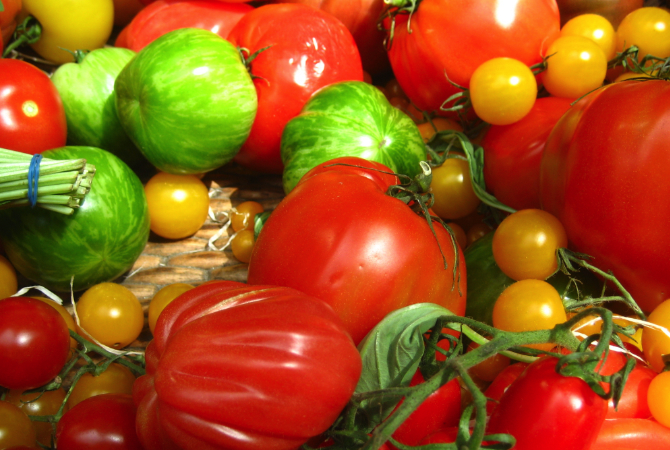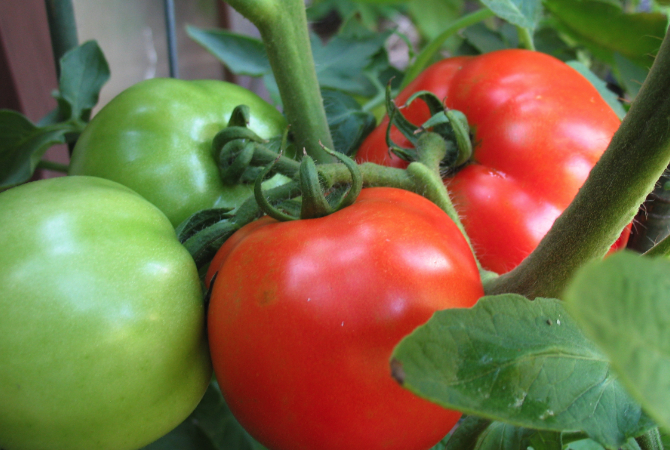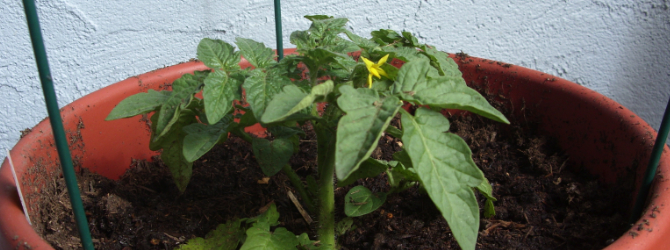Once you’ve sank your teeth into a homegrown tomato, those tasteless, plastic-like things found at the local market just won’t do. Growing tomatoes doesn’t require a large area of garden space, so those with no more than a sunny patio or porch can still grow hardy plants inside containers. Some tomato types grow small enough to thrive in hanging baskets. Before you know it, you’ll be harvesting and indulging in your own tasty and juicy tomato delights.
Tomato Types

There are hundreds of tomato varieties to select from and the vegetable comes in a variety of colours including red, pink and blackish-purple, yellow, green and orange. Tomato fruit sizes and shape vary as well, with some almost as small as a marble, to weighing over 3 kilograms, and some shaped perfectly round and others looking odd and misshapen. Tomato plants have two growth habits, which can determine plant size and habit of fruiting.
Determinate Types: All the fruits are ready to harvest at one time, with flowers and fruits produced at the end of short branches. Determinate types usually are early fruit producers and plant size is bushier and smaller than indeterminate types.
Indeterminate Types: Plants continue to grow, produce flowers and fruits throughout the season until a frost kills the tomato plant. Indeterminate types usually grow large and require caging or staking.
Growing Tomato Plants Inside Containers
Selecting and using the appropriate sized container for your tomato plant will get you off to the right start. Depending on the type, tomato root systems require at least 30cm of space to grow. Therefore, one regular-sized tomato plant that isn’t a cherry variety requires a 19-litre container for adequate spacing and growth. If growing miniature varieties, a 12-litre container is large enough. Make sure the container has bottom drain holes and doesn’t retain water or the tomato plant will develop root rot and die
- Fill the container with an organically rich and well-draining potting mix. Water the potting mix until saturated to settle the soil. Add more potting mix to the container, if needed.
- Dig a hole in the centre of the container’s soil slightly deeper than the container holding the tomato transplant.
- Remove the tomato transplant from its container and gently tease the roots apart. Place the transplant into the hole, making sure to bury it a little deeper than it was previously growing and up to the first set of leaves. This allows the tomato plant to develop a sturdier root structure that will help anchor it in the soil. Firm the soil around the transplant.
- Water the tomato plant, thoroughly saturating the root system. Keep the soil consistently moist, watering when the top inch of soil is dry. Uneven moisture creates cracking of the fruit, as well as contributing to blossom end rot.
- If the tomato type is large-growing, insert a cage over the transplant or place several stakes into the soil after planting. Inserting the cage or stakes at the time of planting, lessens the chance of root damage by installing later in the tomato’s development.
- Fertilise the tomato plant with a 6-8-8 water-soluble blend every two to three weeks.
- Pick off any caterpillars from the tomato plant and drop into a bucket of soapy water.
- If whiteflies or other insects become a problem, use an insecticidal soap product, which is safer for pollinators. Apply when conditions are shady and temperatures aren’t above 32-degrees Celsius.
Tips on Tomatoes

Provided tomatoes have their general growing requirements met, the plants are usually relatively easy to grow, even in containers. By following some basic tomato growing tips, your plants should thrive and be relatively problem-free.
- Tomatoes require at least five hours of full-sun, with eight hours of sun best, for proper growth and fruiting.
- Tomatoes grow best in well-drained, fertile soil with a pH between 5.5 and 7.0.
- Tomato seeds germinate better when temperatures are between 15.55 to 35 degrees Celsius.
- Poor fruit-set can happen due to too much rainfall, too cold temperatures below 12.77 degrees Celsius, as well as temperatures above 32 degrees Celsius.
- Prevent blight by not planting in the same location as the previous year, changing the potting soil in containers with new, and allowing adequate spacing between multiple plants to allow proper air circulation. Space multiple plants approximately 45cm apart.
- If you smoke, wash your hands before touching tomato plants or you can transfer tomato mosaic virus to the plants.
